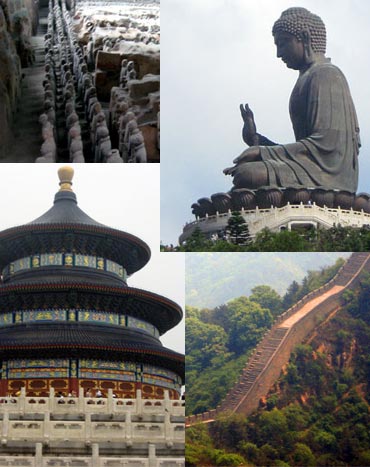My China trip: Going beyond the Great Wall
Last updated on: August 13, 2010 15:51 IST
Photographs: Deepti and Utkarsh Rai
Deepti and Utkarsh Rai, who recently travelled to China share their unforgettable experiences with us.
I took my family on vacation to China, one of the most talked-about countries in recent times. As soon as I landed in Beijing, I heard someone refer to me as a Hindu and wondered why they had started profiling tourists based on religion, but soon I realised that all Indians are called Hindus.
Stepping out of Beijing Airport, I could easily see the massive steps the country has undertaken to improve its infrastructure. However, looking at the sky I witnessed firsthand the much-mentioned 'haze' in spite of the Government's efforts. I met my guide and adjusted myself to speak simple and short English sentences to get the desired reply.
Our first stop was at the famous 'Egg', The National Grand Theatre that opened recently and can house five thousand people at a time. It is an architect's attraction too. A very modern building with three halls, one each for opera, music and theatre and located quite close to the Tiananmen Square. This famous square, with Mao Zedong's huge portrait adorning one side, was shown several times on television during the protests of 1989. But no TV can do justice to capture the vastness of this landmark.
This was once the garden of the adjoining Forbidden City, the residence of the king and royal families for around six centuries. Its access was off-limits to common people, hence the name. One requires good walking shoes to cover hundreds of buildings in this complex.
In China, most such buildings were constructed using wood and were burned down during any power struggle, but the Forbidden City is in pretty good condition, since it was a functional palace until some sixty years ago.
Utkarsh Rai [www.twitter.com/utkarshkrai], based in Bangalore, is the managing director of an IT multinational firm, an author and a globetrotter.
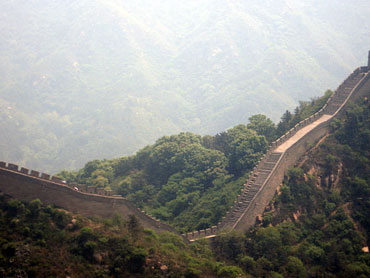
Image: The Great Wall of China certainly deserves a place among one the seven wonders of the world.
Though ornate and brightly-coloured, the royal buildings in China lack intricate architecture.
Naturally, I compared them to the great palaces in India. In comparison to ours, very few artifacts exist inside. This is because most of them were looted or destroyed during the Cultural Revolution that took place a few decades ago. According to one of my guides, the Government had appealed to the people to return the artifacts, in case they had any in their possession.
Although China faced several external attacks in the old days, one of the main threats was from Mongolia, for which they built the Great Wall some two thousand years back. This may be the reason why their palaces were simple and lacked major consideration when it came to protection, like secret passages, tunnels and multiple doors. Our Indian palaces were fortified to such an extent that even opium-fed elephants running amok could not break through the main entrances.
I chose the Badaling section of the Great Wall as my next stop, due to its proximity to the famous Ming Tomb (which is definitely worth a visit), even though I had heard that there were other, less crowded sections of the Wall that provided a better view. It is no exaggeration to say that the sight was breathtaking and certainly deserves a place among one of the wonders of the world. One can take a cable car or just stroll a short distance, but the place was so crowded that I didn't get any quiet time to revel in its beauty and enormity.
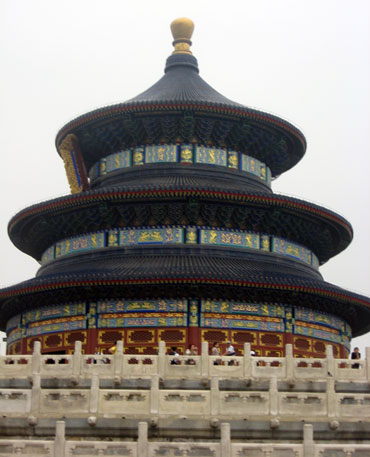
Image: The Temple of Heaven was built in 1420 AD during the Ming Dynasty to offer sacrifice to Heaven.
The next day we went to see the Summer Palace, located inside the city. It is a huge complex with a very beautiful garden and lake. The short boatride was certainly refreshing. The story of Empress Cixi's lust for power and her appointing of the last Emperor of China were narrated by my guide. This story revolves around Beijing and the Oscar-winning movie The Last Emperor has depicted it accurately.
The Temple of Heaven was another imposing structure, which is surrounded by a beautiful garden and is full of domestic tourists. As China has only recently opened its doors to the outside world, most of locals have not interacted much with foreigners and they made several requests for photographs alongside my family. I could see embarrassment on my guide's face and she clarified further that people were also curious to see our long hair and jewellery, which was uncommon during the Cultural Revolution.
Since the 2008 Olympics, I have been eager to see the Bird's Nest (the Olympic stadium) and the Water Cube (the aquatic centre). They are certainly eye-catching and a popular picnic spot for domestic tourists.
We managed to steal some time out of our schedule to make a quick stopover at the Beijing Zoo and visit the section housing the Giant Pandas. It was an experience equally exciting for both children and us adults.
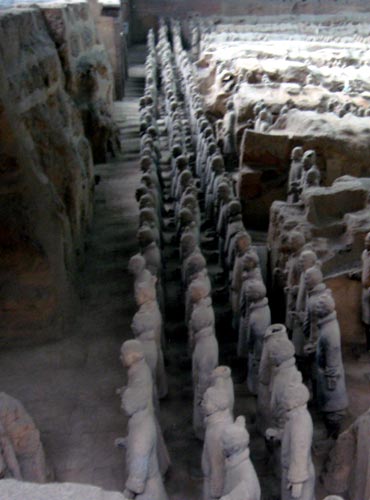
Image: The Terracotta Army complex in Xi'an
No trip to China is complete without retail therapy. Our shopping experience at the Silk Street Mall (which receives tens of thousands of visitors everyday) in Beijing was unique, even for Indians who are supposed to be good at bargaining.
This place requires superior haggling skills, where patience and a smiling face are the main factors that decide who will blink first. 'Are you joking?' is what you're inevitably subjected to when you quote a price.
The non-branded items were cheap and of a reasonably good quality, barring the watches -- and your luck in securing these items plays a major role. It is a common sight to see foreign shoppers buying so much that they end up with extra baggage at the airport.
Our next stop was the city of Xi'an, one of the four ancient capitals of China.
The Hanyang Tomb near the airport is over two thousand years old and well-preserved. It provides a glimpse of what one can expect when visiting the world-famous Terracotta Army complex, also in Xi'an. Our guide took us to a pottery factory before we got to the Terracotta Army, on the pretext of explaining the different ranks of the army. However, we landed up buying an expensive souvenir in the name of quality and later found that the same thing was available much cheaper nearer the complex.
This complex is huge and was built by the self-declared first emperor of China (Qin Shi Huang) in the second century BC, to preserve his dead body. He started this project during his lifetime and started burying all types of figurines of army men and animals and many day-to-day objects, which he would require in his next life.
The excavation work is still underway to find more of these warriors. Xi'an was one of the origination points of the ancient Silk Route, and Muslims have settled here since the seventh century. We strolled along the street and got to see a Chinese-style mosque. Later, we took part in a Chinese tea ceremony, but I still prefer my masala tea!
After this we proceeded to watch a shadow play, which was interesting -- it reminded me of our puppet shows. Old Xian City was fortified and its walls are still well-maintained to walk or ride a bicycle along and relax after a hectic day of sightseeing.
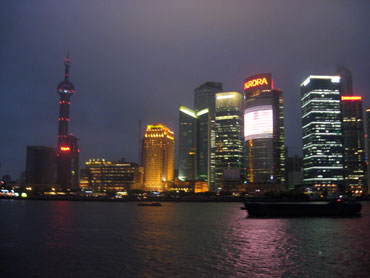
Image: Shanghai city
The biggest surprise of my visit was the Wild Goose Pagoda at Xi'an. I never realised that this was associated with Hiuen Tsang (as his Chinese name was different), the famous Chinese traveller who came to India in the sixth century. He built this pagoda upon his return from India.
The museum at the Pagoda has a collection of articles which he carried back from India including Hindu idols and religious books. These books were translated into Chinese.
We also visited Stone Steles Museum, where ancient Chinese history was written on stones. There were even a few stone tablets with Sanskrit verses inscribed alongside their Chinese translations -- it was heartening to see this.
The famous story 'Journey to the West' ('West' here means India), written some six hundred years ago is well-known to all Chinese and they associate themselves with India in spiritual and religious learnings.
Next we went to Shanghai and the difference was visible as soon as I met the new guide. The sincerity was missing, but the command on English was better. A fast life and the urge to make a fast buck was evident.
Just like the Lama Temple in Beijing, the Jade Buddha Temple here, which houses a jade statue of Buddha, is used for pujas and ceremonies. Jade is found in abundance and considered a pious stone in China. Every woman wears one or two simple jewellery items made from it.
The famous Nanjing Road of Shanghai was worth a walk, although there isn't anything in particular to see. The embankment along the river, called The Bund (an English term, of course) provided a view of two distinct types of architecture from two different periods.
Old Shanghai is around a hundred years old and the new city, which is built on the other side of the river, is hardly a decade old. A walk on The Bund or a boatride can provide a refreshing change from the hustle and bustle of city life. Shopping near Yuyuan Garden was also an experience, although the garden itself is not extraordinary. The garden in Suzohu (our next stop), however, was certainly worth a visit.
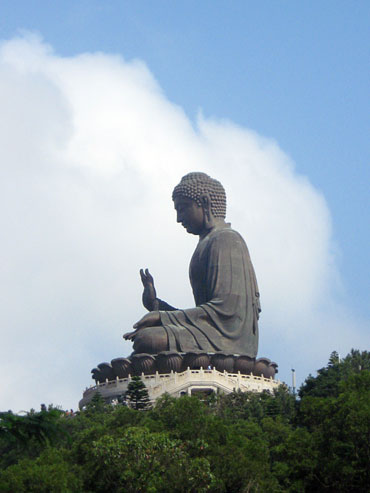
Image: The Tian Tan Buddha statue located near the airport is a popular tourist attraction.
We went to Suzhou by road, which afforded a glimpse of the rapid speed of industrialisation in China. The first stop was Tongli Water Town, a well-preserved tourist spot with water lanes (no comparison with Kumarakom or Venice). Later, we visited a silk factory and got to know that possessing a silk mattress (not just the coverlets!) is a symbol of wealth in China.
Our last stop was Hong Kong, which has many attractions despite being a small island. One should visit Victoria Peak to get a good view of the skyline and the small beach called Repulse Bay.
The seafood dinner cruise is enjoyable, but when you stroll the lane surrounded by aquatic animals performing tricks in the open or inside the huge aquarium, some people are known to get dizzy. I enjoyed the food and my vegetarian wife got something to munch on too.
The cable car ride to a statue of Buddha near the airport is a must. You may prefer to skip a visit to the jade, bird and flower markets. Ten thousand Buddhist temples and the Avenue of Stars were other attractions of the city. We stopped at one famous Taoist temple, where people were using bamboo sticks to tell fortunes.

Image: Tongli Water Town near Suzhou, is a well-preserved tourist spot with water lanes.
Indian restaurants are present in almost all the major Chinese cities, but India is hardly covered in their press and mentioned only in the context of something mystic, funny or very important. They are obsessed with the USA and Europe. Aping America is so over the top that the Chinese have ditched their traditional wedding gowns for white ones.
Hollywood movies decide the local fashion. The striking changes that their society is undergoing are like any other Asian country; they too have a preference for the male child, but together with China's one-child policy, this has adversely impacted the sex ratio with more sons being born than daughters.
The girls, however, are benefitting from this as the financial burden has shifted onto their prospective grooms. One of the female guides commented that she wants a boyfriend who is good-looking, owns an apartment, has enough money to buy a car and has a good job.
Although the Chinese people have a reputation when it comes to physical fitness due to their preference for green tea, walking and cycling, obesity is affecting the younger generations due to the advent of wealth, junk foods and sodas.
The strong central government in China acts fast and is capable of changing the direction of the country in no time. It was in the early fifteenth century that a strong Chinese Navy was dismantled, suddenly paving the way for European dominance and colonisation thereafter. But at this time they appear to be more conscious of their image in the world and they have a strong desire to grab the title of most powerful nation on earth at the earliest.
Want to share your travel stories and pictures? Write to us at getahead@rediff.co.in. We will post the best ones right here on rediff.com!
